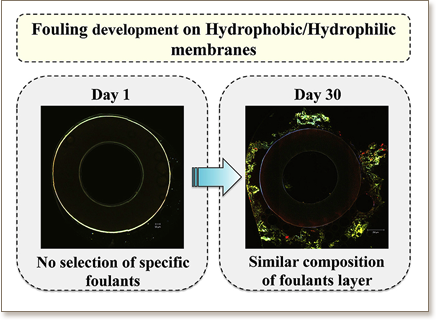Temporal changes in extracellular polymeric substances on hydrophobic and hydrophilic membrane surfaces in a submerged membrane bioreactor
G. Matar, G. Gonzalez-Gil, H. Maab, S. Nunes, P. Le-Clech, J. Vrouwenvelder, P.E. Saikaly
Water Research, 95, 27-38, (2016)

Membrane surface hydrophilic modification has always been considered to mitigating biofouling in membrane bioreactors (MBRs). Four hollow-fiber ultrafiltration membranes (pore sizes ∼0.1 μm) differing only in hydrophobic or hydrophilic surface characteristics were operated at a permeate flux of 10 L/m2 h in the same lab-scale MBR fed with synthetic wastewater. In addition, identical membrane modules without permeate production (0 L/m2 h) were operated in the same lab-scale MBR. Membrane modules were autopsied after 1, 10, 20 and 30 days of MBR operation, and total extracellular polymeric substances (EPS) accumulated on the membranes were extracted and characterized in detail using several analytical tools, including conventional colorimetric tests (Lowry and Dubois), liquid chromatography with organic carbon detection (LC-OCD), fluorescence excitation - emission matrices (FEEM), fourier transform infrared (FTIR) and confocal laser scanning microscope (CLSM). The transmembrane pressure (TMP) quickly stabilized with higher values for the hydrophobic membranes than hydrophilic ones. The sulfonated polysulfone (SPSU) membrane had the highest negatively charged membrane surface, accumulated the least amount of foulants and displayed the lowest TMP. The same type of organic foulants developed with time on the four membranes and the composition of biopolymers shifted from protein dominance at early stages of filtration (day 1) towards polysaccharides dominance during later stages of MBR filtration. Nonmetric multidimensional scaling of LC-OCD data showed that biofilm samples clustered according to the sampling event (time) regardless of the membrane surface chemistry (hydrophobic or hydrophilic) or operating mode (with or without permeate flux). These results suggest that EPS composition may not be the dominant parameter for evaluating membrane performance and possibly other parameters such as biofilm thickness, porosity, compactness and structure should be considered in future studies for evaluating the development and impact of biofouling on membrane performance.